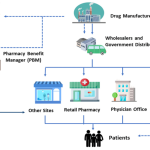Central Fill Pharmacy Automation Market Set for Explosive Growth

The Central Fill Pharmacy Automation Market is poised for substantial growth, with an anticipated increase of USD 480.41 million between 2023 and 2027, as per Technavio‘s analysis. This growth is projected to manifest at a compound annual growth rate (CAGR) of 12.05% over the forecast period. Notably, North America dominated the global market in 2022, with the region expected to witness a remarkable incremental growth of 39%.
Key vendors in this market landscape include Agilent Technologies Inc., ARxIUM Inc., and Becton Dickinson and Co., among others. These companies are strategically leveraging alliances, partnerships, mergers, and acquisitions to capitalize on the burgeoning demand for central fill pharmacy automation solutions.
The market is being propelled by several drivers, including the rising prevalence of chronic diseases and the resultant burden on pharmacies managing multiple medications for patients. With over half of Americans consuming multiple prescriptions daily, the risk of medication errors escalates, leading to adverse health outcomes and increased healthcare expenditures. Centralized prescription filling through pharmacy automation not only enhances filling accuracy but also streamlines pharmacy workflows, ultimately improving patient outcomes.
Technological advancements in pharmacy automation are pivotal for multi-specialty hospitals, specialty medicine, and specialty drugs, contributing significantly to patient care and survival rates for those with chronic illnesses. While initial investments in pharmacy automation, such as automated packaging and pharmaceutical equipment, may seem substantial, they yield long-term savings and ensure compliance with regulatory standards.
Despite the challenges posed by anti-dumping duties and the need for skilled professionals, the market for pharmacy automation systems remains robust, fueled by the imperative for efficient pharmacy workflows and enhanced patient outcomes.
Swisslog Healthcare stands out as a leader in automated pharmacy solutions, offering tabletop systems for prescription filling and tension packaging. These systems are increasingly adopted by hospitals and outsourcing pharmacies to bolster patient safety and staff productivity, particularly for vulnerable demographics like geriatric and obese patients. Compliance with legal guidelines is imperative before implementing automated dispensing systems, underscoring the importance of adhering to regulatory frameworks.
In conclusion, the Central Fill Pharmacy Automation Market is witnessing significant growth globally, driven by the imperative for automation in healthcare to improve operational efficiency and patient care. With advancements in technology and strategic initiatives by key market players, the sector is poised for further expansion in the coming years.





